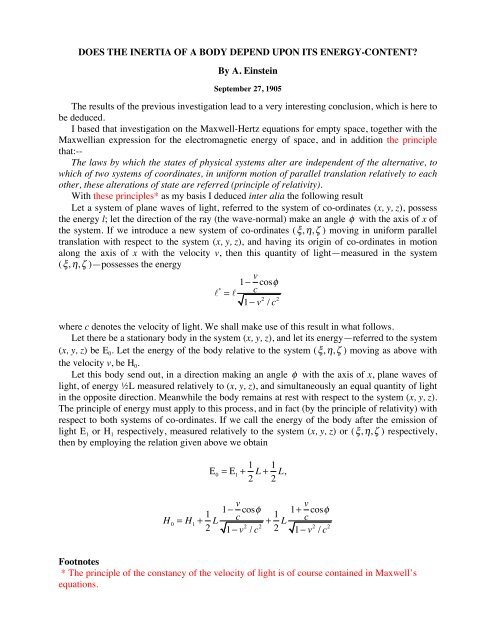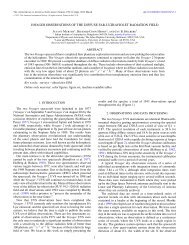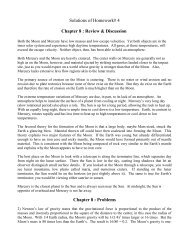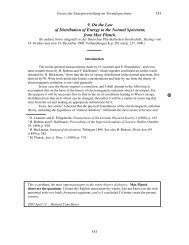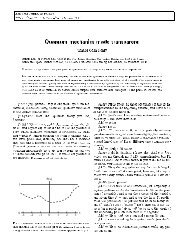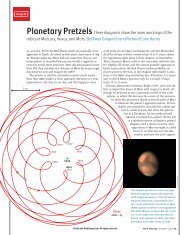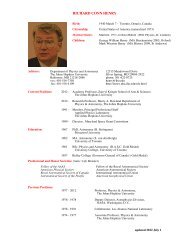DOES THE INERTIA OF A BODY DEPEND By A. Einstein The ...
DOES THE INERTIA OF A BODY DEPEND By A. Einstein The ...
DOES THE INERTIA OF A BODY DEPEND By A. Einstein The ...
Create successful ePaper yourself
Turn your PDF publications into a flip-book with our unique Google optimized e-Paper software.
<strong>DOES</strong> <strong>THE</strong> <strong>INERTIA</strong> <strong>OF</strong> A <strong>BODY</strong> <strong>DEPEND</strong> UPON ITS ENERGY-CONTENT?<br />
<strong>By</strong> A. <strong>Einstein</strong><br />
September 27, 1905<br />
<strong>The</strong> results of the previous investigation lead to a very interesting conclusion, which is here to<br />
be deduced.<br />
I based that investigation on the Maxwell-Hertz equations for empty space, together with the<br />
Maxwellian expression for the electromagnetic energy of space, and in addition the principle<br />
that:--<br />
<strong>The</strong> laws by which the states of physical systems alter are independent of the alternative, to<br />
which of two systems of coordinates, in uniform motion of parallel translation relatively to each<br />
other, these alterations of state are referred (principle of relativity).<br />
With these principles* as my basis I deduced inter alia the following result<br />
Let a system of plane waves of light, referred to the system of co-ordinates (x, y, z), possess<br />
the energy l; let the direction of the ray (the wave-normal) make an angle ! with the axis of x of<br />
the system. If we introduce a new system of co-ordinates (!, ",# ) moving in uniform parallel<br />
translation with respect to the system (x, y, z), and having its origin of co-ordinates in motion<br />
along the axis of x with the velocity v, then this quantity of light—measured in the system<br />
(!, ", # )—possesses the energy<br />
! * = !<br />
1! v c cos"<br />
1! v 2 / c 2<br />
where c denotes the velocity of light. We shall make use of this result in what follows.<br />
Let there be a stationary body in the system (x, y, z), and let its energy—referred to the system<br />
(x, y, z) be E 0 . Let the energy of the body relative to the system (!, ",# ) moving as above with<br />
the velocity v, be H 0 .<br />
Let this body send out, in a direction making an angle ! with the axis of x, plane waves of<br />
light, of energy ½L measured relatively to (x, y, z), and simultaneously an equal quantity of light<br />
in the opposite direction. Meanwhile the body remains at rest with respect to the system (x, y, z).<br />
<strong>The</strong> principle of energy must apply to this process, and in fact (by the principle of relativity) with<br />
respect to both systems of co-ordinates. If we call the energy of the body after the emission of<br />
light E 1 or H 1 respectively, measured relatively to the system (x, y, z) or (!, ",# ) respectively,<br />
then by employing the relation given above we obtain<br />
! 0<br />
= ! 1<br />
+ 1 2 L + 1 2 L, <br />
H 0<br />
= H 1<br />
+ 1 1! v<br />
2 L c cos"<br />
1! v 2 / c + 1 1+ v<br />
2 2 L c cos"<br />
1! v 2 / c 2<br />
Footnotes<br />
* <strong>The</strong> principle of the constancy of the velocity of light is of course contained in Maxwell’s<br />
equations.
= H 1<br />
+<br />
L<br />
1! v 2 / c 2<br />
<strong>By</strong> subtraction we obtain from these equations<br />
( ) = L<br />
H 0<br />
= E 0<br />
! H 1<br />
! E 1<br />
"<br />
#<br />
$<br />
1<br />
1! v 2 / c !1 %<br />
&<br />
2<br />
'<br />
<strong>The</strong> two differences of the form H - E occurring in this expression have simple physical<br />
significations. H and E are energy values of the same body referred to two systems of coordinates<br />
which are in motion relatively to each other, the body being at rest in one of the two<br />
systems (system (x, y, z)). Thus it is clear that the difference H - E can differ from the kinetic<br />
energy K of the body, with respect to the other system (!, ",# ), only by an additive constant C,<br />
which depends on the choice of the arbitrary additive constants of the energies H and E. Thus we<br />
may place<br />
H 0<br />
! E 0<br />
= K 0<br />
+ C <br />
H 1<br />
! E 1<br />
= K 1<br />
+ C<br />
since C does not change during the emission of light. So we have<br />
"<br />
K 0<br />
! K 1<br />
= L #<br />
$<br />
1<br />
1! v 2 / c !1 %<br />
&<br />
2<br />
'<br />
<strong>The</strong> kinetic energy of the body with respect to (!, ",# ) diminishes as a result of the emission<br />
of light, and the amount of diminution is independent of the properties of the body. Moreover,<br />
the difference K 0 - K 1 , like the kinetic energy of the electron depends on the velocity.<br />
Neglecting magnitudes of fourth and higher orders we may place<br />
K 0<br />
! K 1<br />
= 1 2<br />
L<br />
c 2 v2<br />
From this equation it directly follows that:--<br />
If a body gives off the energy L in the form of radiation, its mass diminishes by L/c². <strong>The</strong> fact<br />
that the energy withdrawn from the body becomes energy of radiation evidently makes no<br />
difference, so that we are led to the more general conclusion that<br />
<strong>The</strong> mass of a body is a measure of its energy-content; if the energy changes by L, the mass<br />
changes in the same sense by L/9 × 10 20 , the energy being measured in ergs, and the mass in<br />
grammes.<br />
It is not impossible that with bodies whose energy-content is variable to a high degree (e.g.<br />
with radium salts) the theory may be successfully put to the test.<br />
If the theory corresponds to the facts, radiation conveys inertia between the emitting and<br />
absorbing bodies.


